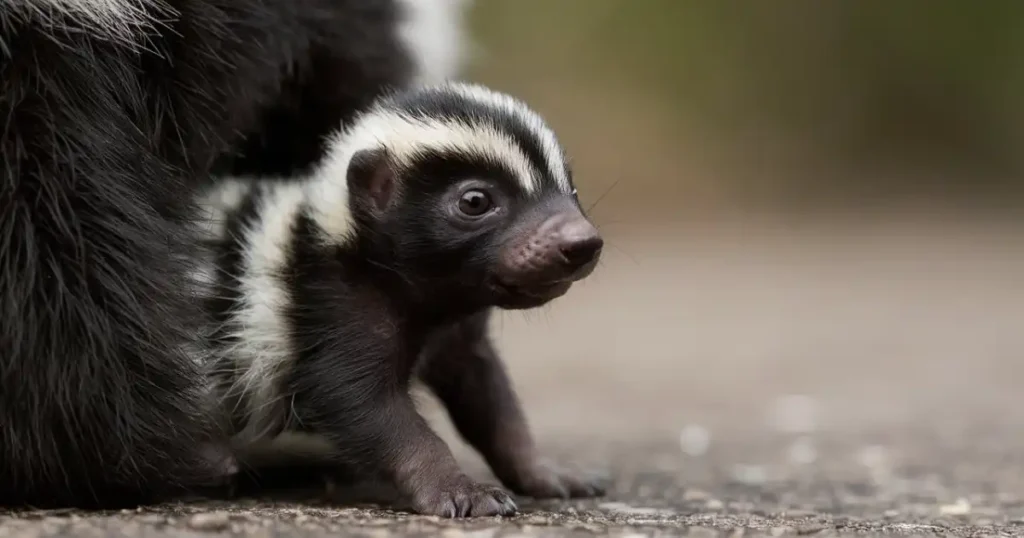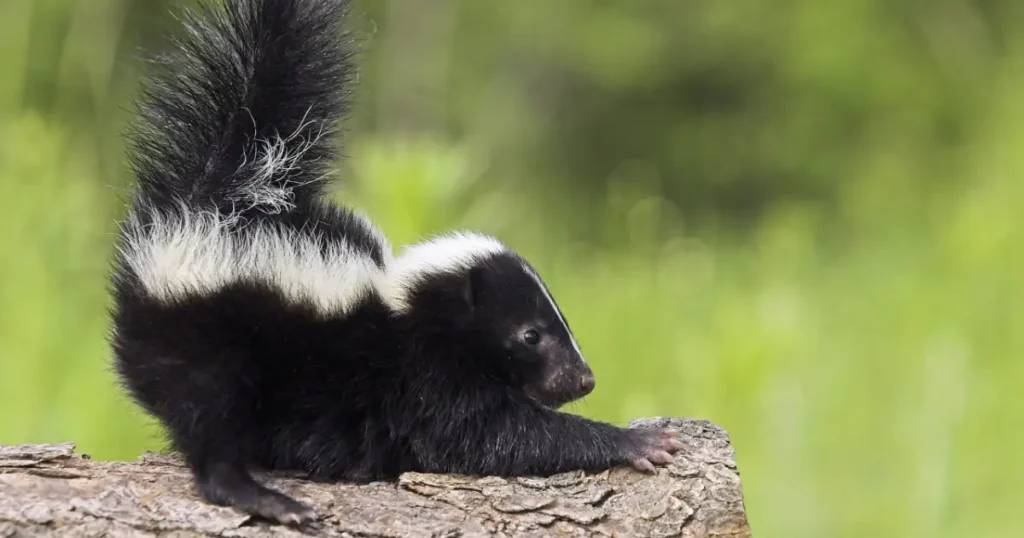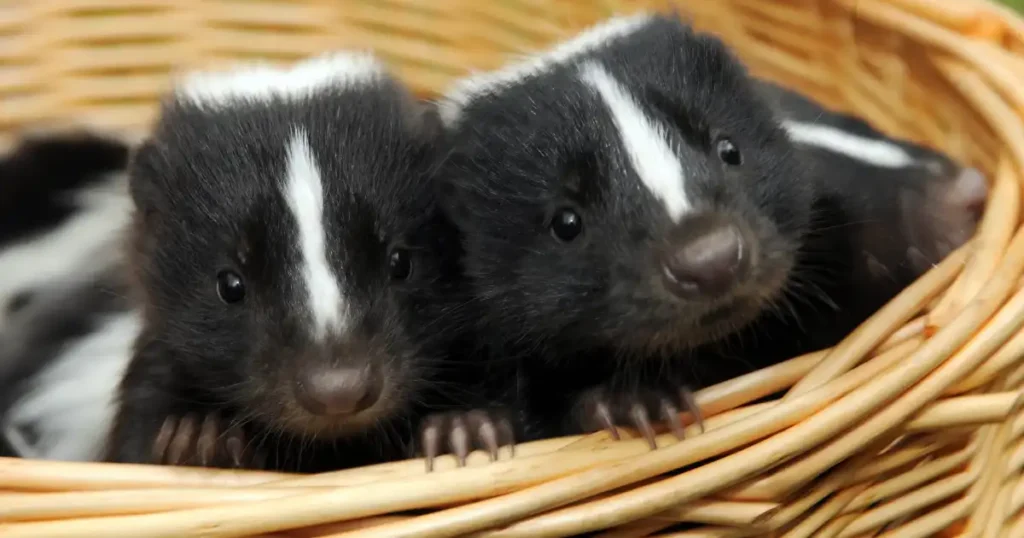
Skunks are fascinating creatures known for their distinctive black and white coloring and their infamous ability to spray a foul-smelling liquid as a defense mechanism. Understanding the terminology related to skunks, particularly their young, can provide a deeper appreciation for these unique animals. In this article, we will explore what's a baby skunk called, delve into their developmental stages, and highlight some interesting facts about these remarkable creatures.
Skunks are small to medium-sized mammals belonging to the family Mephitidae. There are several species of skunks, but they all share some common characteristics, such as their ability to spray a potent and unpleasant-smelling liquid from glands located near their tails. Skunks are primarily nocturnal and are found throughout North and South America.

A baby skunk name is called a "kit." Just like the offspring of cats are called kittens, skunk babies have their unique term. Kits are born blind and deaf, and they rely entirely on their mother for survival during the first few weeks of life. Skunks typically give birth to a litter of kits in the spring, with the average litter size ranging from four to six kits.
Newborn Kits
Newborn skunk kits are tiny and helpless. They are usually born in burrows or other secure locations chosen by the mother. At birth, kits are about the size of a human thumb and weigh only a few ounces. They are covered in a fine layer of fur, but their distinctive black and white coloring is not yet visible.
First Few Weeks
During the first few weeks of life, the kits are entirely dependent on their mother for nourishment and protection. They nurse frequently and grow rapidly. Their eyes and ears begin to open at around three weeks of age, allowing them to start exploring their surroundings.
Weaning and Learning
At about six to eight weeks old, the kits are weaned from their mother's milk and start eating solid food. During this time, they also begin to learn essential survival skills from their mother, such as foraging for food and recognizing potential dangers. The mother skunk is highly protective of her kits and will defend them aggressively if threatened.
Adolescence
By the time they are three months old, the kits are nearly fully grown and resemble adult skunks. They continue to stay with their mother for a few more weeks, honing their survival skills and becoming more independent. By late summer or early fall, the kits are ready to leave their mother's side and venture out on their own.
Skunk Spray
One of the most well-known features of skunks is their ability to spray a foul-smelling liquid as a defense mechanism. Remarkably, skunk kits are born with this ability, although they cannot control it effectively until they are a few weeks old. The spray is a highly effective deterrent against predators, and kits will use it if they feel threatened.
Communication
Skunk kits communicate with their mother and siblings through a variety of sounds, including chirps, squeals, and hisses. These vocalizations help the mother keep track of her kits and alert them to potential dangers.
Diet
As they grow, skunk kits transition from their mother's milk to a diet that includes insects, small mammals, fruits, and vegetables. Skunks are omnivores, and their diet is highly adaptable to the available food sources in their environment.
Habitat
Skunks are adaptable animals and can live in a variety of habitats, including forests, grasslands, and urban areas. Mother skunks typically choose secure, hidden locations to give birth and raise their kits, such as abandoned burrows, hollow logs, or under buildings.

Skunks play a vital role in the ecosystem by helping to control insect and rodent populations. As omnivores, they consume a wide range of food items, including many pests that can damage crops and spread disease. By keeping these populations in check, skunks contribute to the overall health of their habitats.
Avoiding Conflicts
While skunks are beneficial to the environment, they can sometimes come into conflict with humans, especially when they take up residence near homes or gardens. To avoid conflicts, it is essential to secure trash cans, remove potential food sources, and seal any openings that might serve as denning sites for skunks.
Humane Removal
If a skunk does take up residence in an undesirable location, it is important to use humane methods to encourage the animal to leave. This is where professional wildlife control services, such as Critter Stop, come into play. Critter Stop specializes in humane skunk trapping and removal, ensuring the safety of both the skunk and the people involved. They have built a fantastic reputation, backed by numerous positive customer reviews, for providing high-quality work and excellent customer service.

Threats to Skunks
Despite their adaptability, skunks face several threats in the wild. Habitat destruction, road mortality, and conflicts with humans are significant challenges for skunk populations. Urbanization leads to the loss of natural habitats, forcing skunks to move closer to human settlements where they are at higher risk of being harmed.
Conservation Efforts
Conservation efforts for skunks focus on habitat preservation and public education. Protecting natural areas and creating wildlife corridors can help ensure that skunks have safe places to live and breed. Educating the public about the benefits of skunks and how to avoid conflicts can also play a crucial role in their conservation.
Research and Monitoring
Ongoing research and monitoring of skunk populations are essential for understanding their ecology and developing effective conservation strategies. By studying skunk behavior, diet, and habitat use, scientists can gain insights into the factors that influence their survival and reproduction.
Cultural Significance
Skunks have held various roles in the folklore and cultural narratives of different societies. In Native American folklore, skunks are often depicted as symbols of caution and defense due to their unique ability to spray. Some tribes view skunks as protectors, while others associate them with humility and respect.
Modern Depictions
In modern culture, skunks are frequently portrayed in media and entertainment, often highlighting their distinctive spray as a comedic element. Characters like Pepe Le Pew from Warner Bros. cartoons have popularized the skunk’s image, making it a recognizable and somewhat endearing animal despite its notorious defense mechanism.

Pros of Keeping a Pet Skunk
Pet skunks can be affectionate and playful companions. They are intelligent animals that can be trained to use a litter box and perform tricks. Pet skunks are often de-scented at a young age to remove their ability to spray, making them more manageable as household pets.
Cons of Keeping a Pet Skunk
Despite their charm, skunks require specialized care and a significant commitment from their owners. They need a balanced diet, regular veterinary check-ups, and mental stimulation to stay healthy and happy. Additionally, skunks have strong natural instincts and may exhibit behaviors such as digging and foraging, which can be challenging in a home environment.
Best Times and Places to Observe
Skunks are primarily nocturnal, making dusk and dawn the best times to observe them in the wild. They are often found in areas with abundant food sources, such as fields, forests, and suburban neighborhoods. Observing skunks from a safe distance is crucial to avoid startling them and triggering their defensive spray.
Safety Tips
When observing skunks, it is essential to remain calm and quiet. Do not approach or attempt to handle a skunk, as this can provoke a defensive response. If you encounter a skunk, back away slowly and give it plenty of space to move away. Using binoculars or a camera with a zoom lens can help you observe skunks closely without disturbing them.

Myth: Skunks are Aggressive
One common misconception is that skunks are aggressive animals. In reality, skunks are generally docile and prefer to avoid confrontation. They will only spray as a last resort when they feel threatened and have no other means of escape.
Myth: Skunks are Dirty and Disease-Ridden
Another myth is that skunks are dirty and carry many diseases. While skunks can carry diseases such as rabies, they are not inherently dirty animals. Like other wildlife, they play an essential role in the ecosystem and contribute to controlling pest populations.
Myth: Skunks Only Eat Garbage
It is a misconception that skunks primarily scavenge through garbage for food. In the wild, skunks have a varied diet that includes insects, small mammals, fruits, and vegetables. They are opportunistic feeders and will eat what is readily available, but they do not rely solely on human garbage for sustenance.
Wrapping up these information on what do you call a baby skunk, rather “skunk kits”, or “baby skunks”, both ways, these are remarkable creatures with unique characteristics and behaviors. From their early days of helplessness to their development into independent adults, skunk kits undergo a fascinating transformation. Understanding and appreciating theseanimals can help us coexist with them and recognize their importance in maintaining a healthy ecosystem. Conservation efforts, public education, and responsible pet ownership are all crucial components in ensuring the well-being of skunk populations. Observing skunks in the wild can be a rewarding experience when done safely and respectfully, allowing us to witness the beauty and complexity of nature up close.
For those dealing with skunk issues near their homes, professional help is highly recommended. Critter Stop is a trusted name in humane wildlife removal, offering expert skunk trapping and removal services.
With their fantastic reputation and numerous positive customer reviews, Critter Stop ensures high-quality work and excellent customer service.
High-Quality Work: Critter Stop is known for their meticulous and effective wildlife control solutions.
Great Customer Service: With numerous positive reviews online, Critter Stop excels in customer satisfaction, providing personalized and responsive service.
Humane Methods: They prioritize humane wildlife removal, ensuring minimal harm to the animals while effectively addressing your pest control needs.
Expertise: Critter Stop's team of professionals is well-trained in handling a wide range of pests, including skunks, ensuring your home remains pest-free.
Contact us at (214) 234-2616 to get a free estimate of our services.
Visit our Critter Library and learn more about our furry friends